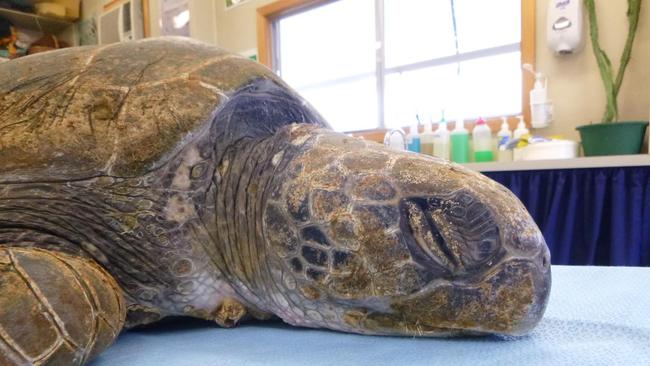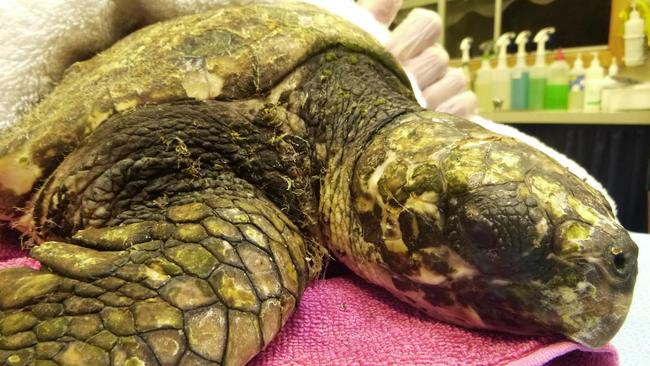Lost ‘floater’ turtles washed up in South Australia ready for release in Byron Bay
THEY’RE called “floaters”, sick turtles who can’t dive because they’re clogged up with plastic. Two of have been nursed back to health at Port Adelaide and will soon be released in eastern Australia.
TWO lost sea turtles who found themselves stranded in the chilly waters of South Australia are now just days away from an all-expenses paid relocation flight to sunny Byron Bay.
Janelle, a 32kg green turtle, and Alicia, a 5.5kg juvenile loggerhead, have been recovering for months at the Australian Marine Wildlife Research and Rescue Organisation facility on Torrens Island at Port Adelaide.
Janelle was found on a beach near Robe in October, while Alicia was discovered after being washed ashore at Cape Jervis about a month later.
Both reptiles were in poor condition — malnourished and covered in algae and barnacles.
AMWRRO’s president and founder Aaron Machado said both Janelle and Alicia were “floaters” — a condition which was usually brought about by the ingestion of plastic or other indigestible materials.

“That’s the most common cause — a foreign body ingestion,” Mr Machado said.
“This blocks up the small intestine, everything backs up inside them and nothing can be digested.
“Gases then develop under the surface of the carapace (shell) and they float like a cork.”
Mr Machado said that once a turtle became a floater it was unable to submerge and was then left at the mercy of oceanic currents and winds.
Once rescued, the turtles were rehydrated via a drip, the built-up gas was released and the pair was fed up on a diet of fish until they had regained the weight they’d lost.
The flippered friends are two of a number of turtles the organisation has rehabilitated over the years, including a wayward hawksbill sea turtle whose DNA revealed that it originated in the Middle Eastern country of Oman.

Other animals rescued and rehabilitated by Mr Machado and his dedicated team of volunteers include penguins, dolphins, dozens of species of sea birds and even elephant seals.
As for Janelle and Alicia, they’ll be packed into specially-made crates and put on a plane bound for Coolangatta some time next week.
“I have their export permits ready to be attached to their containers,” Mr Machado said.
“I’ve spoken to New South Wales and they’ve put in their import permits to match up with their export permits.
“There’s quite a bit of bureaucracy involved, as turtles obviously have no idea where the state borders are.” After their arrival on the Gold Coast the turtles will then be taken to the Byron Bay region, where they’ll either be released from the beach or taken by boat to Julian Rocks, a couple of kilometres offshore.
“They’ll be flipper-tagged, and the numbers will be recorded on the website seaturtles.org,” Mr Machado said.
“There’s a group called The Friends of Byron Bay who actually swim across the bay every morning — which if you know the size of the fish swimming out there these days is pretty brave — and they record the numbers of any turtles they come across.”
Mr Machado said that while he had to remain optimistic for Janelle and Alicia’s futures, it was hard not to worry about them.
“The first piece of plastic man ever made is still floating around in the ocean somewhere,” he said.
“People think that plastic bags are the Grim Reaper.
“And don’t get me wrong, plastic bags are bad — but it’s often the hard plastics that actually brings these guys undone.
“It’s the broken cigarette lighter floating on the surface, or that 50c bucket that’s become brittle and broken into a hundred pieces.
“You put a little turtle like Alicia back into the ocean and just hope she won’t eat any plastic for the next 50 years.
“That’s all you can do — hope.”
To find out more about AMWRRO’s work go to www.amwrro.org.au
